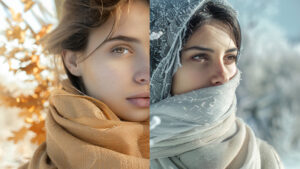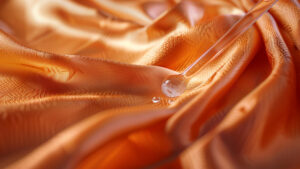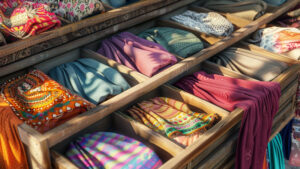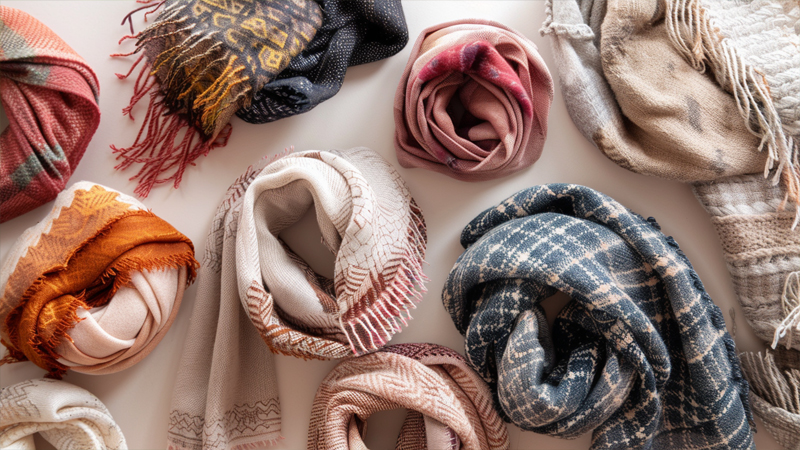
I’ve always been amazed at how a simple scarf can transform my outfit.
Women’s scarves come in different materials, lengths, patterns, and functions, giving us endless options to express personal style.
I’d love to share more.
What material choices exist for women's scarves, from silk to wool?
Materials can drastically change how a scarf feels and looks.
Silk brings elegance, cotton offers breathability, wool adds warmth, and blends strike a balance for year-round versatility.
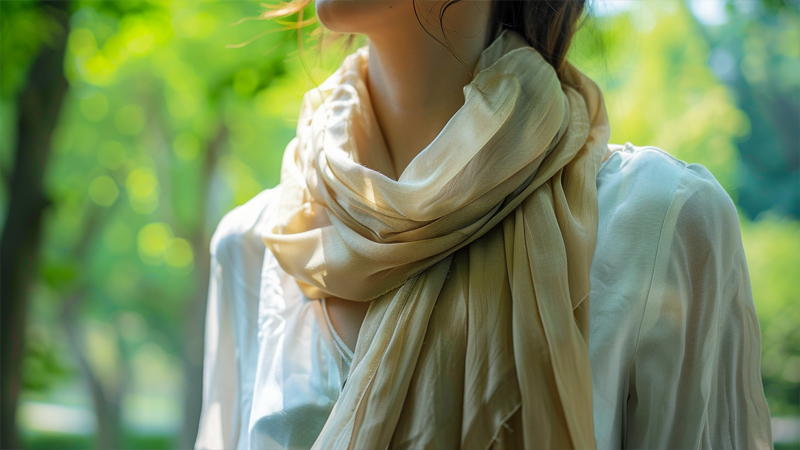
When I first tried a silk scarf, I felt instantly refined—like I’d stepped into a classic movie scene. Silk drapes elegantly1, catching the light in a way that highlights its sleek texture. At the same time, it can sometimes feel too delicate for everyday errands. That’s when I reach for cotton or linen scarves, which are more casual and breathable. They suit a relaxed day at the park or a quick run to the grocery store. Wool wraps, on the other hand, are my go-to for chilly winters. I remember one particularly cold afternoon when my wool scarf felt like a cozy blanket around my neck—just enough warmth without the bulk of a heavy coat.
Finding Your Perfect Fabric
Deciding on a material often depends on the weather, your personal style, and the level of care you’re willing to commit to. Silk demands gentle washing or dry cleaning, while cotton and wool can be more forgiving2. Of course, blends are also an option. A cotton-silk blend, for instance, pairs the softness of cotton with a hint of silk’s luster. Blends can give you that sweet spot between comfort and visual appeal. Some scarves even incorporate synthetic fibers—like polyester—that make them more durable and easier to clean. This can be handy if you’re prone to spills or leading a very on-the-go lifestyle.
Another factor is how each material interacts with prints or dyes. Silk and satin scarves typically produce more vibrant patterns because their smooth surface holds color beautifully. Meanwhile, linen or cotton might have a slightly muted finish, offering a laid-back look. Each fabric has a personality: silk is luxurious, wool is snug, cotton is fresh, and linen feels earthy. In the end, it’s about mixing and matching materials to suit both your practical needs and the vibe you want to share with the world. Over time, you’ll find a preference—or a few favorites—that make you feel amazing the moment you drape them over your shoulders.
How do length and size variations affect scarf styling?
The shape and size of a scarf can change everything.
Long scarves wrap multiple times for warmth or drama, while shorter options keep things simple and sleek.
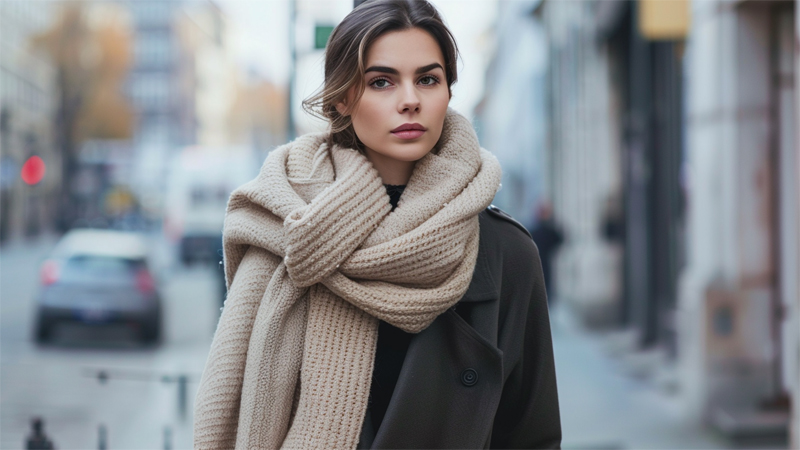
I once had a scarf so long, I felt like I could wrap myself in it twice over—and I did! That extra fabric felt dramatic, letting me experiment with creative knots and layered looks. A really long scarf can double as a shawl in cooler weather or transform into a belted wrap over a simple dress. On the flip side, smaller scarves—like bandanas3—are perfect when I just want a quick pop of color without the extra bulk.
Playing With Proportions
- Oversized scarves4: Fantastic for layering or doubling as a light blanket on a plane or in the office. If you’re feeling adventurous, you can even drape it over your shoulders like a cape.
- Medium-length scarves: Offer balance. They’re long enough for a stylish twist but not so massive that you’ll spend hours figuring out how to wear them.
- Square bandanas: Great for tying around your neck, hair, or even your wrist as an accessory. I love grabbing one when I want to tame frizzy hair or add a retro touch.
When considering length, think about your personal style and daily routine. If you like more elaborate styles, a longer piece gives you room to experiment—knots, loops, braids, you name it. If minimalism is your thing, a shorter scarf saves time and fuss. Also consider your height and body type. A huge blanket scarf might overwhelm a petite frame, while a skinny scarf might get lost on someone taller. Ultimately, it’s all about whether you feel comfortable. I’ve had days when I craved that dramatic swoosh of fabric behind me, and others when a small, neat bandana was all I needed. Try different lengths to see how they complement your outfits, your mood, and even the weather. Over time, you’ll figure out which styles match your personality best. After all, scarves aren’t just about warmth—they’re a reflection of who we are, wrapped up in a little fabric.
How do pattern and color selections influence overall look?
Patterns and colors change the mood of any outfit.
Vibrant prints turn heads, subtle designs give polish, and color choices can set your style’s tone.

I’ve noticed my wardrobe gravitates toward solid colors, so when I introduced a bright patterned scarf, it felt like a fun, bold move. Suddenly, a simple white blouse looked runway-worthy. Patterns can inject excitement—whether it’s a striking geometric print or a playful floral motif. On days when I want something more understated, a solid-colored scarf in a rich shade, like burgundy or navy, can instantly elevate my jeans-and-tee uniform.
Experimenting With Style Statements
- Bold prints: Animal prints, large florals, or abstract shapes can be the centerpiece of your outfit. Keep the rest of your look simple to let the scarf shine.
- Subtle patterns: Small polka dots, stripes, or gentle swirls add interest without overwhelming the eye. These work well in professional settings or when you want a soft flair.
- Neutral tones: Beige, gray, and black scarves match almost anything, making them handy for quick mornings or travel. They’re like the reliable best friend of your closet.
- Bright hues: Reds, pinks, or turquoise scarves can boost your mood and show off a more playful side.
Colors also influence how people perceive you—and how you feel about yourself. A bright scarf can make you seem energetic or approachable, while neutral shades might come across as calm and sophisticated. I’ve even used color to echo the season. Pastels for spring, earth tones for fall—it’s a subtle way to connect with nature’s palette. The best part? You don’t have to overhaul your entire wardrobe just to explore a fresh color scheme. A scarf can do that for you in seconds. If you’re nervous about experimenting, start small. Maybe pick a scarf with a subtle pattern or a pop of color along the borders. Over time, you might be ready for that all-over abstract design you once admired from afar. Trust me, a little color or pattern goes a long way in making your style feel unique.
What distinguishes functional scarves from decorative ones?
Some scarves focus on warmth or protection, while others highlight style and flair.
Functional pieces use thicker fabrics or specific features, whereas decorative scarves accent outfits with minimal bulk.

I once owned a fleece-lined scarf that felt like a cozy hug around my neck on cold mornings. It wasn’t exactly runway-ready, but it kept me comfortable when the temperature dropped. That’s the essence of a functional scarf5—it aims to protect or serve a clear purpose. On the other end of the spectrum, decorative scarves6 might be airy, sheer, or heavily embellished. They can’t always shield you from windchill, but they sure look stunning draped over your shoulders at a special event.
Balancing Utility and Style
Sometimes, we want a scarf that does both. A pashmina7, for instance, can be wrapped snugly for warmth or worn loosely for a classy finish. Performance scarves, like those made with moisture-wicking fabrics, come in handy for workouts or outdoor adventures. Meanwhile, purely decorative scarves might feature sequins, embroidery, or delicate lace—eye-catching details, but not always practical for everyday errands. The trick is to recognize the main reason you’re wearing a scarf. Are you stepping out into a snowstorm or heading to a formal dinner?
I remember layering a functional scarf under a decorative one when I visited a mountain resort. The thick inner scarf kept me toasty, while the outer piece looked elegant for photo ops. Yes, it was double the effort, but I felt stylish and warm. Many scarves fall somewhere in between, offering moderate warmth with a stylish edge. Wool scarves can be dyed in beautiful patterns, while cotton scarves can come with subtle embroideries. In the end, it’s about personal preference and occasion. Don’t hesitate to mix and match different types to find the perfect balance. That’s the beauty of having options—you can pick a scarf that suits both your needs and your sense of adventure.
Conclusion
Scarves let me switch up my look, protect me from the elements, and show off my style all at once.
-
Explore how silk's unique properties contribute to its elegant drape, enhancing the sophistication of any outfit. ↩
-
Discover the practical benefits of cotton and wool scarves, making them ideal for everyday wear with minimal maintenance. ↩
-
Explore innovative and stylish ways to incorporate smaller scarves, such as bandanas, into your daily outfits for a quick pop of color and retro vibes. ↩
-
Learn how oversized scarves can elevate your fashion game, serving not just as a cozy accessory but also as a bold fashion statement for any season. ↩
-
Discover top-rated functional scarves that combine warmth and comfort, perfect for braving the cold weather. ↩
-
Learn creative ways to style decorative scarves, adding elegance and flair to your formal attire. ↩
-
Explore versatile styling tips for pashminas, blending warmth with chic elegance for any occasion. ↩

